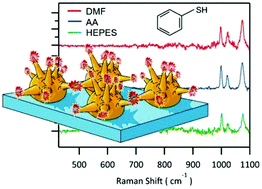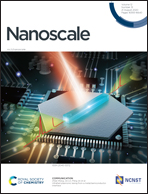Large-area periodic arrays of gold nanostars derived from HEPES-, DMF-, and ascorbic-acid-driven syntheses†
Abstract
With arms radiating from a central core, gold nanostars represent a unique and fascinating class of nanomaterials from which extraordinary plasmonic properties are derived. Despite their relevance to sensing applications, methods for fabricating homogeneous populations of nanostars on large-area planar surfaces in truly periodic arrays is lacking. Herein, the fabrication of nanostar arrays is demonstrated through the formation of hexagonal patterns of near-hemispherical gold seeds and their subsequent exposure to a liquid-state chemical environment that is conducive to colloidal nanostar formation. Three different colloidal nanostar protocols were targeted where HEPES, DMF, and ascorbic acid represent a key reagent in their respective redox chemistries. Only the DMF-driven synthesis proved readily adaptable to the substrate-based platform but nanostar-like structures emerged from the other protocols when synthetic controls such as reaction kinetics, the addition of Ag+ ions, and pH adjustments were applied. Because the nanostars were derived from near-hemispherical seeds, they acquired a unique geometry that resembles a conventional nanostar that has been truncated near its midsection. Simulations of plasmonic properties of this geometry reveal that such structures can exhibit maximum near-field intensities that are as much as seven-times greater than the standard nanostar geometry, a finding that is corroborated by surface-enhanced Raman scattering (SERS) measurements showing large enhancement factors. The study adds nanostars to the library of nanostructure geometries that are amenable to large-area periodic arrays and provides a potential pathway for the nanofabrication of SERS substrates with even greater enhancements.



 Please wait while we load your content...
Please wait while we load your content...